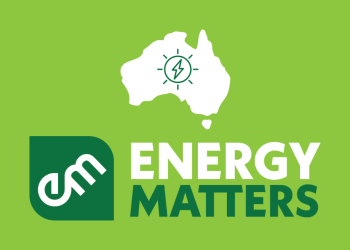Electricity prices in New South Wales (NSW) remain a constant pressure on households, and the state’s transition away from coal is testing the grid’s ability to stay reliable. Rooftop solar has eased some of the burden, and home batteries are growing in popularity, but most battery systems only provide a few hours of storage. That leaves a gap between when the sun goes down and when households need power most.
A new approach known as gravity storage could help close that gap. In Russel Vale, a disused coal mine shaft is being repurposed for AU’s first underground gravity storage trial. If it succeeds, it could point to a new way of stabilising renewable energy and keeping household bills in check.
Why NSW needs more than solar and batteries
NSW is moving quickly to close ageing coal plants, and solar is now one of the state’s largest sources of daytime electricity. Yet the demand pattern doesn’t match the generation curve. Most households run appliances, heating, or cooling in the late afternoon and evening, when the sun has already set. That mismatch creates pressure on the grid and keeps reliance on expensive gas-fired “speaker” plants in place.
Lithium-ion batteries have been the obvious solution so far, both at home and on-grid scale installations. They can absorb excess solar energy during the day and release it in the evening. However, most of these batteries are designed for short-term storage, typically lasting two to four hours. That helps with the early evening peak, but it does not solve longer gaps caused by cloudy days, wind lulls, or extended demand spikes.
This is where long-duration options like gravity storage are drawing attention. By providing storage that lasts longer than a typical household battery, they could strengthen the grid and reduce the price shocks that flow through to energy bills. For NSW households, the question is whether these technologies can scale fast enough to replace the reliability once provided by coal.
The Russel Vale Trial — A new chapter for old coal mines
In Wollongong’s northern suburbs, the disused Russel Vale coal shaft is about to take on an entirely new role. Instead of bringing coal to the surface, it will be used to lift and lower heavy weights, storing and releasing energy through gravity.
That project, led by Australian company Green Gravity, marks the country’s first underground gravity storage trial. The shaft will serve as a test bed for a technology that could eventually operate at scale across former mines.
The appeal lies in reusing infrastructure that already exists. Mine shafts provide the vertical drop required for gravitation storage without the need to construct tall towers or new excavations. By converting these assets, the cost of development falls, environmental impact is reduced, and communities that once relied on coal gain a pathway into the renewable energy economy.
For Wollongong, a city long associated with heavy industry, the project symbolises both economic transition and innovation in clean energy. If the trial proves successful, it could pave the way for similar projects across NSW and other states, turning the legacy of coal into an asset for a renewable grid.
How gravity storage works and why it’s different
The principle behind gravity storage is simple: lift a heavy mass to store energy, and lower it to release that energy. In systems like the one planned at Russel Vale, excess renewable electricity will drive motors to raise massive weights inside the mine shaft. When electricity is needed, the weight is lowered, and the motion drives generators to produce power. The process is mechanical, not chemical, which gives it different strengths and weaknesses compared with batteries.
Lithium-ion batteries are highly efficient and can respond instantly, but they degrade over time and are best suited to short bursts of storage. Gravity systems have lower round-trip efficiency, often around 70-80 per cent compared with 85-95 per cent for batteries, but they can operate for decades with little loss in performance. They also avoid the fire risks and supply chain constraints associated with lithium.
Compared to pumped hydro (which uses water instead of weights), gravity storage can be built in smaller footprints and does not require valleys or large reservoirs. That flexibility makes it attractive in regions with old mine shafts or existing industrial infrastructure. For homeowners, the key difference is not whether you’ll install one in your backyard, but how projects like Russel Vale could change the way renewable energy is stored and delivered across the grid.
What it could mean for NSW households
The main benefit of gravity storage for households is indirect, but no less important. By providing long-duration storage, it could help shift renewable energy into the times of day when homes need it most. That means more solar power available after dark and less reliance on expensive gas generators to cover evening peaks.
If gravity storage can be deployed at scale, it could help smooth out wholesale electricity prices. Lower volatility in the market usually translates into more stable retail bills, even for households without home batteries. This kind of storage also strengthens the grid against blackouts during heatwaves or unexpected demand spikes, offering peace of mind as coal power stations retire.
For households that already export solar to the grid, stronger storage capacity could also improve the overall value of renewable generation. Instead of flooding the grid with excess supply in the middle of the day at low feed-in tariff (FiT) rates, gravity storage creates the possibility of shifting that energy into higher-value evening periods. The result is a system that works better for solar owners and non-solar households alike.
Optimism vs. reality
The Russel Vale trial has generated interest because it showcases a novel way to extend renewable storage. Industry leaders see gravity storage as part of the mix Australia needs to back up solar and wind, and the reuse of existing mine shafts adds an appealing layer of sustainability. There is optimism that this technology could complement batteries and pumped hydro to deliver the long-duration storage the grid lacks.
But it is still early days. Gravity storage is largely unproven at grid scale, and questions remain about cost, efficiency, and commercial viability. Building reliable systems that compete with well-established technologies will take time, investment, and clear market rules. For now, projects like Russel Vale are proof-of-concept exercises designed to test performance in real conditions.
For households, that means the benefits are not immediate. It will take years before projects like this can have a noticeable effect on electricity prices or reliability. The optimism lies in knowing that alternatives to lithium batteries are being explored, giving Australia a broader toolkit to support its renewable transition.
Gravity storage won’t replace rooftop solar or home batteries, but it could become a vital piece of the energy puzzle. For NSW households, trials like Russell Vale signal a future where renewables are more reliable, affordable, and available when they’re needed most.
Energy Matters has been in the solar industry since 2005 and has helped over 40,000 Australian households in their journey to energy independence.
Complete our quick Solar Quote Quiz to receive up to 3 FREE solar quotes from trusted local installers – it’ll only take you a few minutes and is completely obligation-free.















